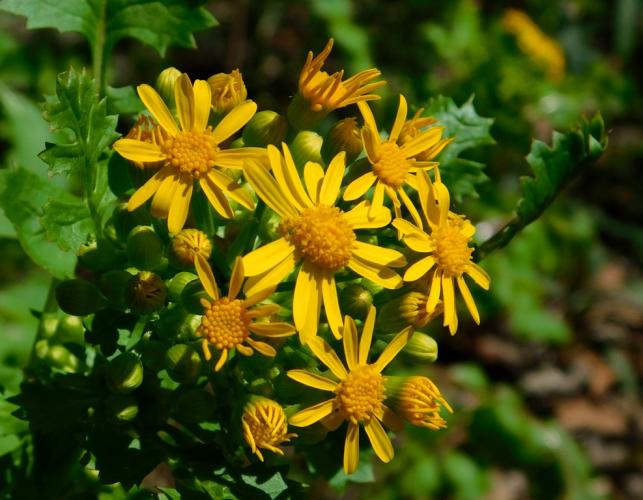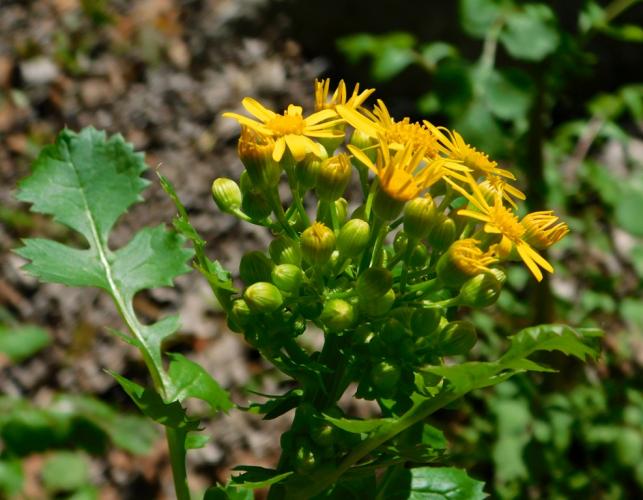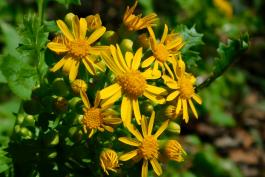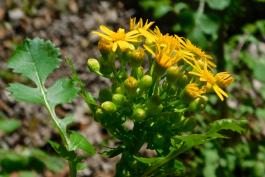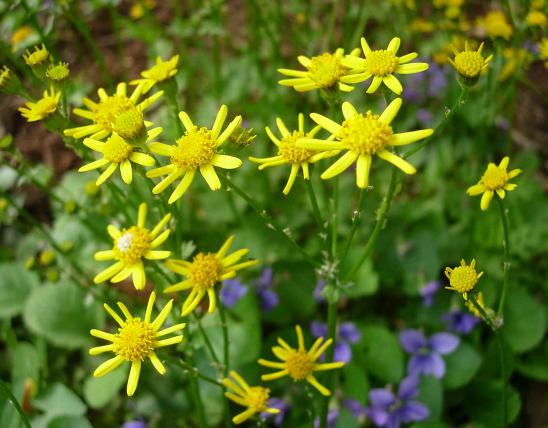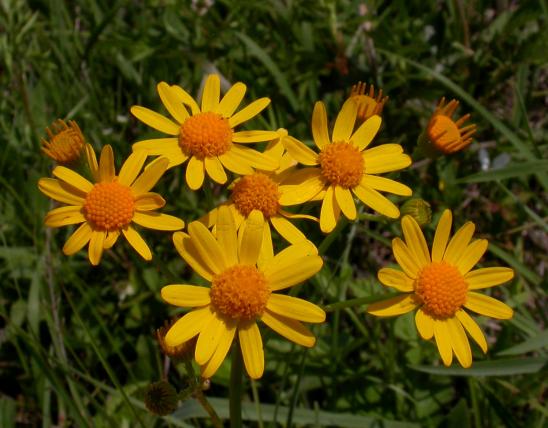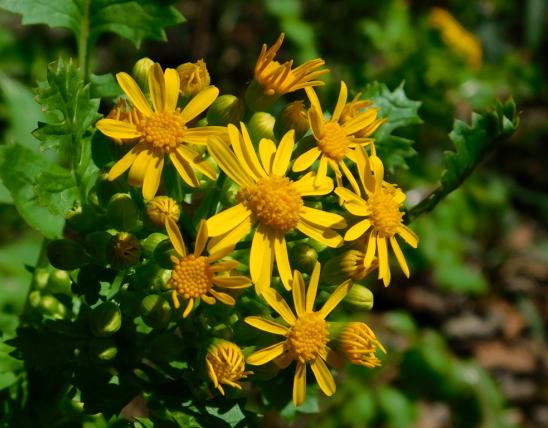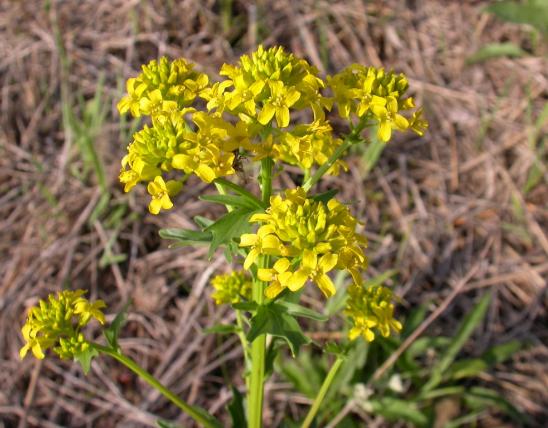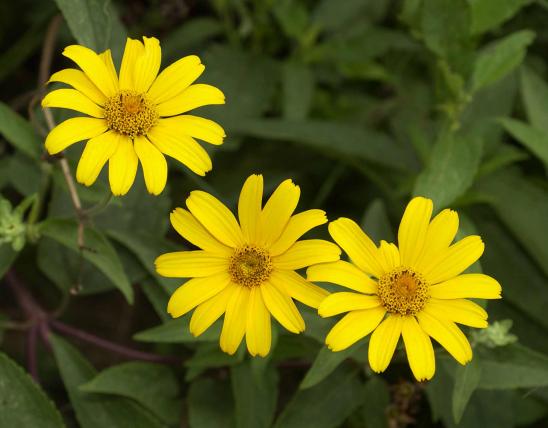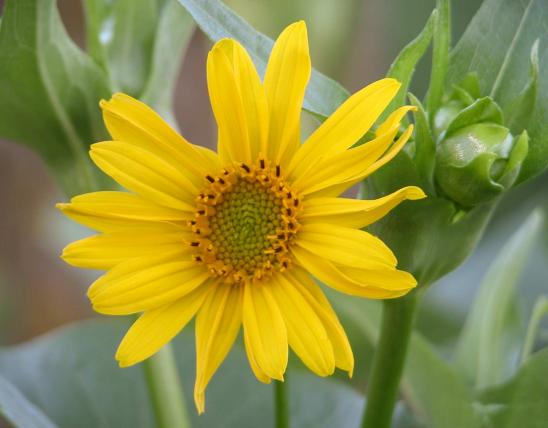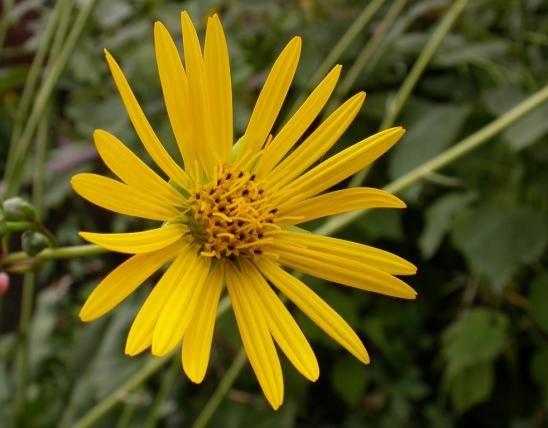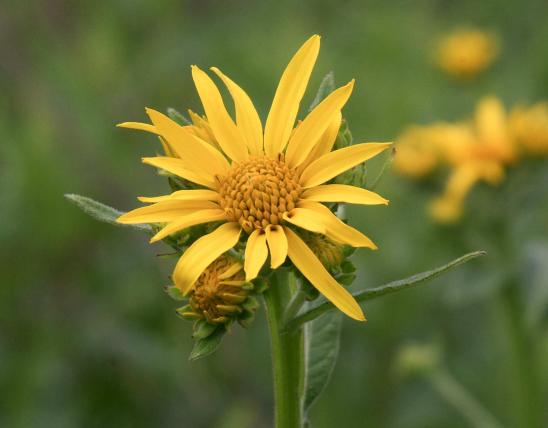
Ragworts or groundsels have several common names, and separating the different species can be a little tricky. But members of genus Packera, with their bright yellow daisy-like flowers, are distinctive as a group. Seven species have been recorded in Missouri.
Overall Description
Ragworts may be annual, biennial, or perennial, and rootstocks may be rhizomes, stolons, or merely fibrous. They are typically erect, single-stemmed plants that are unbranched below the flower cluster. Take note of any presence or absence of hairs on the stalk, as this can aid in identification.
Leaves initially form in a basal rosette, and these basal leaves may or may not be present at flowering time (whether they are present is another key for distinguishing among the species). Basal leaves may have long petioles (leaf stems). Higher on the stem, the leaves are alternate and are gradually smaller as you move upward. Look at both basal and stem leaves: the shape of the leaf blades is important for species identification; note characters of teeth, tip, and shape of base where it attaches to petiole. Leaves may be unlobed, pinnately lobed, or pinnately compound, sometimes all on the same plant, depending on the position on the stem. Also note presence or absence of hairs (hairs, if present, are typically woolly or cobwebby).
The yellow, daisy-like flowerheads are about ½–1 inch across, in a loose, broadly rounded or rather flat-topped cluster at the top of the stalk. The involucre (base of the flowerhead) is cylindrical, wedge-shaped, or shaped like a half circle; the green involucral bracts generally appear long, parallel-sided, and fairly flattened on the exterior surface; sometimes the bract tips are purplish. The petal-like ray florets are bright yellow, usually 8–13, relatively narrow, usually with 3 tiny teeth at the tip. The disc florets are also bright yellow. Most Missouri ragworts have their peak bloom in May.
The fruits are achenes (structurally, they’re like sunflower or dandelion seeds) topped with a crowning tuft (pappus) of whitish bristles; at maturity, each flowerhead looks something like a small (marble-sized), fuzzy dandelion head.
Missouri’s Species
Missouri has seven species of packeras that have been recorded growing in natural settings. All are native Missouri wildflowers. Leaf characters are the best way to tell them apart. Habitat is an important clue, too. Below they are listed roughly in order by how widely distributed or common they are in the state.
- Round-leaved groundsel, or roundleaf ragwort (P. obovata), has mostly basal leaves whose blades are rounded to spoon-shaped, toothed, with the leafy tissue conspicuously continued into the leaf stem. Stem leaves are few, sessile (stalkless), often deeply lobed. Flowerheads terminal on a long stalk with few leaves. Ray flowers few, looking somewhat ragged. Perennial, to 2 feet tall, usually grows in colonies. Blooms April–June. Rich or rocky woods, bases of bluffs, on slopes, mostly south of the Missouri River.
- Prairie ragwort (P. plattensis) has mostly basal leaves; the lowest of these have paddle-shaped blades with a pointed tip and have long petioles (leaf stems); the base of the blade tapers or is abruptly contracted where it joins the petiole. Lowest stem leaves deeply pinnately lobed or appearing pinnately compound. Stem leaves few, sessile (clasping), short. Basal and stem leaves are sharply toothed. Usually a perennial, to 2 feet tall; starts out a hairy plant with white, cobwebby hairs; these are often worn away by flowering time except for patches at the leaf bases or flower cluster branch points. Flowerheads are few to many, terminal, with few ray flowers. Blooms May–June. Prairies, dry, open uplands, scattered statewide. To distinguish it from the similar, but less widespread northern ragwort, see that species listed below.
- Golden ragwort (P. aurea) has mostly basal leaves whose blades are heart-shaped, with a pointed tip, crenate (scalloped or round-toothed) to coarsely toothed, on very long petioles (leaf stems). Stem leaves are very few, small, and pinnately lobed. Frequently the plant has a purplish main stem. Perennial, to 2½ feet tall. Flowerheads are numerous and similar to those of P. obovata. Blooms April–June. Low, moist areas, including near spring outlets, generally south of the Missouri River. To distinguish it from the similar, but less widespread western golden ragwort, see that species listed below.
- Butterweed (P. glabella) usually has no basal leaves at flowering time; the stem leaves, however, are largest at the base of the plant and get gradually smaller up the stem. The blades are deeply pinnately lobed, with toothed margins. Usually an annual with fibrous roots, lacking rhizomes or stolons, to 3 feet tall, unbranched, smooth, without hairs, growing in colonies, at times covering acres of floodplain. Stems often inflated or hollow. Flowers abundant, with rich golden heads with few ray flowers. Blooms April–June. Floodplains of the Mississippi and Missouri rivers and their tributaries, in southeastern and east-central Missouri. From a distance, colonies of butterweed may be misidentified as colonies of yellow rocket (a type of mustard).
- Northern ragwort, or balsam groundsel (P. paupercula), is scattered in Missouri, mostly in the northern half of the state, and occurs in upland prairies, loess hill prairies, openings of mesic to dry upland forests, ledges of bluffs, and rarely in bottomland forests; also on pastures, railroads, and roadsides. A perennial, blooming April–August. It is closely related to prairie ragwort, which also lives in open habitats, and the two can be difficult to tell apart. Northern ragwort tends to lose more of its hair as it matures, while prairie ragwort retains more. Northern ragwort tends more commonly to produce short rhizomes with few stolons (runners), while prairie ragwort more commonly produces slender stolons (runners). The leaf blades of northern ragwort are usually more than 3 times as long as they are wide, while those of prairie ragwort are less than 3 times as long as wide.
- Western golden ragwort, or falsegold groundsel (P. pseudaurea), is scattered in western and northern Missouri and occurs in bottomland prairies and forests, mesic upland forests in ravines, banks of streams and rivers, and occasionally ledges of bluffs; also in pastures and ditches. A perennial, blooming April–June. This species is closely related to golden ragwort, and the two can be difficult to tell apart. Western golden ragwort has basal leaf blades that are oblong-ovate to broadly lance-shaped, and usually truncate (squared-off) or only shallowly cordate at the base; also, it tends to have ascending leaves, and its involucral bracts frequently have little purplish color. Meanwhile, golden ragwort has basal leaf blades that are rounder (oblong-ovate to nearly circular), truncate or cordate (heart-shaped) at the base, with at least some deeply cordate; also, its leaves tend to droop and spread, and its involucral bracts often are noticeably purple, at least toward the tip. The Missouri representatives of western golden ragwort are variety semicordata.
- Woolly ragwort, or hairy groundsel (P. tomentosa), is known in our state from only a single historical collection in the late 1800s from a riverbank in southwestern Missouri (Eagle Rock, Barry County). Its overall range is mostly in the southeastern United States, especially the coastal plain, ranging as far west as Oklahoma and Texas. A perennial, blooming March–May. This ragwort is more or less evenly and persistently covered with dense, felty (tomentose) hairs (though the leaf blades, especially the upper surfaces, may be nearly hairless by flowering time). It is a Missouri species of conservation concern; there is still some hope it might be rediscovered in our state.
Similar Species
More than 300 species in the daisy-aster-sunflower family grow in Missouri, and many of them, like ragworts, are yellow and look something like daisies. Hopefully, the pictures, size, and overall growth form will help you learn to recognize members of genus Packera as a group.
In places where two or more species of Packera grow together, they sometimes create hybrid offspring that display a blend of characteristics of the parent species. In some cases, it raises questions among botanists about how to determine precise boundaries between the various species.
Two species in genus Senecio, also called ragworts and groundsels, have been recorded in Missouri; they differ from our Packera species by having the leaves all sessile (stalkless), while our native packeras have at least the basal leaves with a long, well-defined leaf stem. Both of the senecios are nonnative annuals and are uncommon to rare in Missouri:
- Common groundsel (Senecio vulgaris), a native of Eurasia, is uncommon and sporadic in Missouri, mostly recorded from the St. Louis metro region. It sometimes is spread as weeds in bedding plants and encountered in greenhouses and gardens, along railroads, and in other open, disturbed areas. It lacks petal-like ray flowers, and the leaves are mostly pinnately lobed.
- Texas groundsel or Texas ragwort (Senecio ampullaceus), native to Texas, has been recorded from railroads in the St. Louis area. Leaves start off with cobwebby hairs; at maturity, they are smooth. Upper leaves on the stem are sessile (clasping), unlobed, and shallowly toothed.
Height: most species are 2–2½ feet.
Statewide. Different species have different habitat preferences and distributions within the state. See the descriptions above.
Habitat and Conservation
Habitat varies with species; see the descriptions above.
Status
Native Missouri wildflowers.
Several species are popular in native wildflower gardening.
Plants are toxic if eaten by people, livestock, or other animals.
Woolly ragwort, or hairy groundsel (P. tomentosa), is a Missouri species of conservation concern, listed as “SH,” meaning that it once occurred here but is possibly extirpated; there is still some hope it might be rediscovered in our state.
Missouri’s species in genus Packera used to be grouped with about 3,000 other species into a gigantic genus Senecio. Today, even with the packeras and several other groups split away, Senecio is still a huge genus with more than 1,200 species, mostly in the Old World. Only two species of true senecios have been recorded in Missouri, both introduced/nonnative and uncommon.
Human Connections
P. aurea and P. obovata are the most commonly used ragworts for native wildflower gardening. They are somewhat weedy, and in the right situations with moist soils, they can naturalize and spread into large patches by stolons and self-seeding. They bloom profusely in spring, with a long blooming period. When the plants aren’t blooming, trim the spent flower stalks: the basal leaves can function as an interesting, semi-evergreen ground cover. Also used in rain gardens. Bees and other pollinators love the flowers.
Ragworts contain toxic pyrrolizidine alkaloid chemicals and are poisonous if eaten. They also have a long history as medicinal plants. Native Americans, settlers, and others have used them for treating a variety of ailments, including delayed and irregular menstruation and complications of childbirth. This is apparently how these plants acquired one of their common names, since they were associated with women’s reproductive health issues.
The common name “ragwort” probably refers to the ragged look of the upper stem leaves on many of these plants. The common name “groundsel” has Middle and Old English precedents, with early forms of the word being groundeswele and grundeswelge, roughly meaning “ground swallower.” This apparently came from the rapid way some related plants could spread across a patch of ground. The common name “butterweed,” used for several species worldwide, is for the yellow color of the flowers.
The genus name, Packera, honors Canadian botanist John G. Packer (1929–2019), who was born and raised in England but moved to Edmonton, where at the University of Alberta he became an authority on Arctic and alpine plants and literally wrote the book on the flora of Alberta.
As noted under Status, these ragworts used to be included in genus Senecio, so don’t be surprised to find them listed under that name in older field guides. Per the laws of botanical nomenclature, which follow the grammatical rules of Latin, several of the species names changed endings to match the gender of the new genus. For example, Senecio aureus became Packera aurea, and S. obovatus became P. obovata.
The former genus name, Senecio, means “old man” (it’s related to the words senescent and senile). It refers to the mature flowerheads, which, being rounded, gray, and fuzzy, kind of resemble the head or beard of an elderly man. The effect is especially striking when the wind blows away some of the seeds at the top of the head so the bare, rounded receptacle is visible through the ring of remaining gray fluff.
Ecosystem Connections
Deer, rabbits, livestock, and other herbivorous mammals tend to avoid ragworts due to toxic pyrrolizidine alkaloid chemicals in the plants’ tissues.
A wide variety of bees, flies, beetles, and other insects visit the flowers for nectar and pollen.
One of Missouri’s rarer butterflies, the northern metalmark (Calephelis borealis), uses P. obovata and possibly also P. aurea and maybe some types of fleabane daisies (Erigeron) as caterpillar food plants. The northern metalmark is a species of conservation concern in Missouri, occurring only in the southwest part of the state. Our northern metalmark populations are isolated from the broader historic range of the species. This butterfly occurs only in small, localized populations and is rare, declining, threatened, or endangered throughout its range.
The white-crossed seed bug (Neacoryphus bicrucis) is an attractive insect that is notable for feeding on ragworts. Apparently it can sequester the plant’s toxic chemicals in its tissues, providing it protection from predators. The bug’s bright colors probably serve as warning coloration.
An attractive geometrid moth called “the gem” (Orthonama obstipata) uses ragworts as well as several other kinds of plants as larval food plants. It is found worldwide. It may not be able to survive Missouri’s cold winters, but after years when all its eggs, larvae, pupae, and adults are zapped by freezing weather, this moth always recolonizes our state from populations that survived winter to our south.




